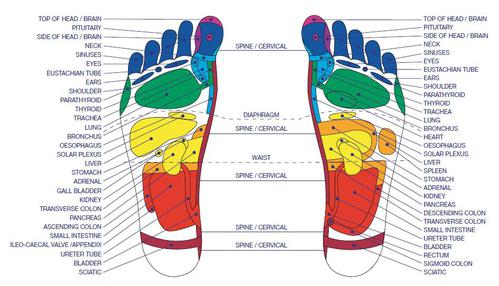Massaging the Pressure Points on Your Feet Will Surprise You!
Foot massages feel great. Especially, if you've been doing a fair amount of walking or simply standing for a long time. But did you know that massaging specific foot pressure points can relieve a lot of health problems?
Curing ailments by massaging pressure points in feet is called reflexology in modern lingo, although its roots lie in a branch of traditional Chinese medicine known as acupressure. Let's see how massaging pressure points in your feet may heal different parts of your body.
While science doesn't back up all the reflexological healing properties, a study of 60 patients showed that this technique can help relieve chronic pain, stress, and anxiety. In this section, we'll detail how the pressure points in feet are connected to the different organs. Also, we'll see how they help to unblock your chi*.
- Traditional Chinese medicine believes that energy or chi flows through your body's median pathways. Any upheavals in your body result from blocked chi pathways.
All You Need to Know about Foot Pressure Points
1. The relationship between pressure points and the different body parts
- Head and neck
Your head and neck are connected to your toes via median pathways: the second and third toes are connected to your eyes while the rest of the toes are linked to your teeth, sinuses, and top of the head. Healing any ear problems means massaging the section just below your toes.
- Spine
Your spine is connected to the inside or arch of your foot. Massaging the inside of your foot may help in case of persistent pain in this region due to bad posture. Physiotherapists recommend using a bit of oil or moisturizer to make the therapy a bit smoother.
- Chest
Your chest region is connected to the area under your toes. Except for the big toe, you can apply pressure under each toe to reach your lungs. You may apply pressure two inches below your middle toe to affect the heart.
- Stomach
Your stomach is connected to the center of your left foot. Reach a little lower and you can heal issues related to your left kidney. If you shift a little to the right during the massage, you are able to reach the pressure point connected to your spleen.
- Legs
The pressure point to relieve pain in your legs is connected to the heel of your foot. By massaging this part, you can relieve pain in your ankles, thighs as well as rheumatism in your leg joints. Massaging this pressure point might reduce swelling in your feet while providing relief from back pain.

2. Points you need to press for healing targeted parts
- Tai Chong
Tai Chong is the indent between your big and second toes. When you press this portion, you may feel soreness. Massaging and pressing this point helps to soothe stress and anger. You may also feel relief with respect to physical issues like headaches and irritability.
- Yong Quan
This pressure point is located directly below the depression under your big toe joint. Pressing this point may help you get rid of issues like palpitations, sleeplessness, hot flashes, and night sweat. Paying attention to this pressure point might make you less anxious.
- Da Dun
This pressure point is located in the inner portion of your big toe, only a bit away from the corner of your toenail. Press this point to relieve stomach aches, dizziness, and hernia.
- Tai Bai
This pressure point is located on the ball of your feet. Locate it by pressing along the sides of your feet till you reach a part where you feel enough pressure. Massaging this portion eases pain from diarrhea, dysentery, and bloating.
- Tai Xi
Tai Xi is located between your Achilles tendon and the bump of your ankles. Massaging this portion will relieve pain from bronchitis, sore throat, asthma issues, and even arthritis.
Techniques to Massage Your Pressure Points on Feet
- Concentrate on the pressure points in the arches of your foot, ankles, and heel. Physiotherapists recommend using a bit of oil or moisturizer for a smoother therapy session.
- Activate a pressure point pressing down for 10 seconds three times in a row.
- You can also keep a golf ball or tennis ball under the arch of your feet to activate the pressure points while sitting in a comfortable position. Roll this ball around, so you can soften the particular pressure point.
Precautions While Massaging the Pressure Points
- Traditionally, massage comprises larger movements like long strokes and kneading, but reflexology calls for micromovements to activate your pressure points.
- Avoid putting too much pressure on sore spots as that can lead to unforeseen damage and pain.
- A little disclaimer for those who have diabetes! Consult your doctor before massaging pressure points as nerve damage related to diabetes can be made worse by massaging the pressure points in your feet.
Final Takeaways
There's a ton of anecdotal and some scientific evidence that massaging the feet pressure points can help resolve a host of issues, especially those related to stress, anxiety, and chronic pain. Besides, who doesn't love a foot massage? Go right ahead and give your feet some love and care because they certainly do a lot of hard work!
YOU MAY LIKE
-
Best Ways to Use ACV to Treat Warts
-
Top 7 Natural Remedies for Dry Eyes
-
Top 3 Foods to Consume for Stomach Ulcer Treatment at Home
-
Best Ways to Use Apple Cider Vinegar for Yeast Infection
-
The Best Home Remedies for Sore Throat: Get a Relief Now!
-
Acupressure and Natural Remedies for Treating Headaches
-
7 Most Important Acupressure Points
-
The Best Warts Home Remedy: Tea Tree Oil
-
The Best Guide to Treat an Ear Infection at Home
-
Is Peppermint Tea an Effective Solution to Stomach Ailments?
